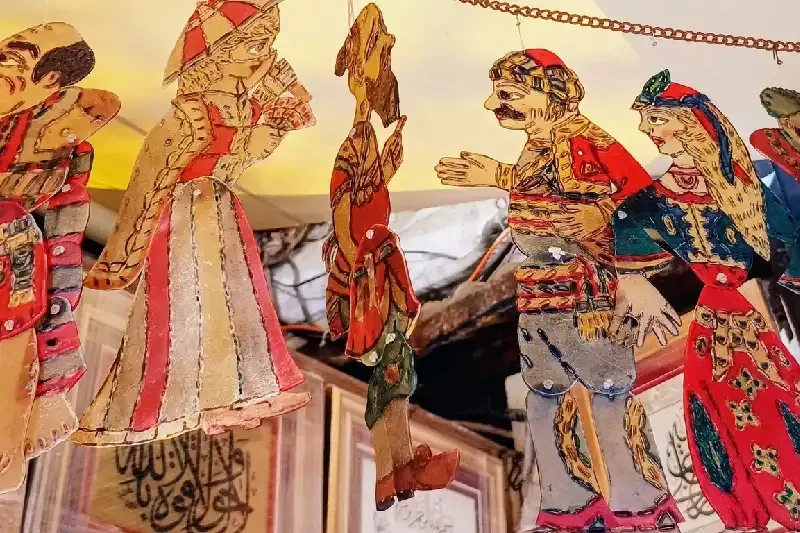Turkish Theatre and Cinema
Turkish theater and cinema reflect rich cultural traditions, from Karagöz and Meddah to globally acclaimed films, shaping Turkey’s artistic legacy.
.webp)
Turkish theater and Cinema art weaves a captivating tale that spans centuries. From the earliest theater inception during the 13th century to the busy studios of 1914, this performing art form offers three distinctive performance traditions - Ortaoyunu, Meddah, and Karagoz. Each tradition carved its own place in the history of Turkish entertainment, creating pillars for the future of artistic endeavors.
The Turkish cinema spectacularly took off in the golden age of Yesilcam, making the country the fifth-largest producer of films in the world. Studios produced a whopping 300 films annually, an unmatched burst of creativity. The beginnings of this art form could be traced back to the mid-19th century when Naum Theater, Turkey's first purpose-built theater, was founded.
Modern Turkish entertainment has the world captivated with its compelling storylines and intense culture. Turkish television programs have viewers in 150 countries, ranging from the cosmopolitan Middle Eastern cities to the vibrant Latin American communities. These stages present a wide variety of Western-style theatrical productions as well as characteristically Turkish interpretations of age-old classics.

Early Forms of Turkish Theater
From the interactions of the tribes in the 10th century emerged three great theater traditions, each painting Turkey's cultural landscape with various hues: Ortaoyunu, Meddah, and Karagöz.
Traditional storytelling forms
Meddah storytellers, who had perfected their craft since the 16th century, wove hypnotic tales with dramatic flair. These skilled artists took their inspiration from nomadic traditions and shamanistic mythology, crafting religious epics and heroic legends. Their creative canvas soon expanded to include secular tales peppered with wit, biting satire, and incisive social commentary. Palace halls and humble coffeehouses rang with Meddah performances, particularly on holy Ramadan evenings and festive occasions.
Shadow puppet plays
Karagöz theater captivated audiences with its supernatural shadow puppets, elaborately cut-out characters crafted from translucent water buffalo or camel skin. Skilled artisans created these masterpieces using sharp steel tools, imbuing them with vibrant vegetable dyes that mirrored the diversity of Ottoman society. Two favorite characters dominated the scene - the smart-aleck Karagöz and intellectual Hacivat, their contrasting personalities mirroring society's fascinating extremes.
Folk performances
Ortaoyunu introduced theater to public squares from the 13th century. These enchanting open-air plays flourished with minimal props - a simple tent only - relying on witty improvisation and charming audience interaction instead. Traditional music and dance saturated these performances, enriching Turkey's celebratory tradition. These artistic communions strengthened communal ties, especially at wedding ceremonies and national celebrations.
The multiculturality of Ottoman society was reflected in these performances, with characters embodying various ethnicities and social ranks. Each role had its own distinctive markers - distinctive accents, regional dialects, and characteristic musical motifs - creating a rich mosaic of cultural expression. Rural communities particularly loved these theater traditions, embracing them as sources of both entertainment and social discourse.

Birth of Turkish Cinema
Motion pictures first laid their captivating spell on Ottoman soil in 1896, mere months after the Lumière Brothers' legendary Paris exhibition. Yıldız Palace hosted this historic event as French juggler Bertrand presented the motion picture wonder before Sultan Abdülhamid II and his stunned court.
First Film Screenings
Sponeck Pub in Beyoğlu offered the initial public exposure to this new art form, presented by D. Hanri. Viewers sat mesmerized despite the strong smell of petroleum lamp projectors, their eyes fixed on this "magical invention". The popularity of cinema soon spread across Constantinople, and Cambon's shows at Varyete Theater and Monsieur Constinsouza's shows at Halep Bazaar drew crowd after crowd.
A visionary Jewish-Polish entrepreneur, Sigmund Weinberg, directed Turkish cinema's first chapter from his modest camera equipment store in Yüksekkaldırım. His clever business acumen earned him exclusive Ottoman distribution rights from European trailblazers, particularly the Lumière Brothers.
Early Production Attempts
Turkish cinema found its voice in 1914 through Ayastefanos'taki Rus Abidesinin Yıkılışı (Demolition of the Russian Monument at San Stefano), superbly directed by Fuat Uzkınay. This early documentary, made in collaboration with Austrian Sascha-Meester Gesellschaft, represented the symbolic destruction of a Russian monument of the 1877-1878 Russo-Ottoman War.
Military patronage was important during these early years. İsmail Enver Pasha established the Military Office of Cinema in about 1915. Two respectable institutions - Society of National Defense and Society of Disabled Veterans - initiated filmmaking activity, creating productions that encouraged support for war action and for soldiers as well.
Early feature film ventures weathered tough conditions. Weinberg's 1916 release of Himmet Aga'nin Izdivaci (The Marriage of Himmet Aga) was brought down by wartime necessity when its thespians volunteered for the Dardanelles call. Triumph was achieved through writer Sedat Simavi's persistence, and the first Turkish public features, Pence (The Claw) and Casus (The Spy), were released in 1917. This Turkish golden age reached its zenith with the establishment of Kemal Film in 1922, the nation's first private film studio.
Explore the best Turkey Travel Packages!
Customize Your Dream Vacation!
Get in touch with our local experts for an unforgettable journey.
Plan Your TripThe Golden Age
Turkish cinema boomed exponentially during the 1960s, hitting record numbers as the world's fourth-largest film producer. Istanbul's Beyoğlu district, particularly Yeşilçam Street, was bustling with creative energy as film studios churned out 241 classics.
Rise of Yesilcam
Winds of freedom swept through Turkish cinema after the 1960 military coup. A new, liberal constitution ignited artistic freedom, and cinema's first golden age started. Cinemas proliferated on Turkish landscapes, offering magical realms at low costs. Turkish people grabbed onto this cultural renaissance with both hands - by 1970, a record 220 films were being produced.
Star System Emergence
Yeşilçam's sky was full of star talents whose mere presence guaranteed box office successes. There were four shining stars - Türkan Şoray, Hülya Koçyiğit, Fatma Girik, and Filiz Akın - that ruled this golden period. The "Sultan" herself, Türkan Şoray, made her mark in the annals of cinema history with an unprecedented 222 films.
The aesthetic quality of Turkish films earned worldwide recognition when Metin Erksan's "Susuz Yaz" (Dry Summer) took the prestigious Golden Bear at Berlin's Film Festival in 1964. The golden period lasted until 1975, when television's popularity and rising production costs began dimming cinema's bright lights.
Master directors Ömer Lütfi Akad, Ertem Eğilmez, and Atıf Yılmaz formed the artistic conscience of this golden period. Their cinematic vision ideally balanced social consciousness with popular entertainment, creating timeless classics that spoke to hearts and minds alike.
Modern Transformation
Turkish cinema has dazzled with new dynamism since the 2000s, becoming Europe's second-largest market. New narrative voices blend seamlessly with technical sophistication.
Digital Innovation
Digital magic reshapes Turkish cinema's creative palette. Filmmakers employ high-tech digital cameras, cutting-edge editing facilities, and stunning visual effects, particularly boosting action and drama films. Cinema magic is plentiful through CGI wizardry, blue/green screen techniques, and digital compositing, which enable filmmakers to think on a larger scale. Turkish stories now enthrall audiences in 150 countries through streaming services, bypassing traditional distribution constraints.
New Storytelling Styles
Modern Turkish cinema is talking in fresh and distinctive voices, married to stark realism and refined simplicity. Storytellers are crafting close portraits of everyday life, teasing out human identity, isolation, and nostalgic memory. Streaming platforms encourage such narrative innovations, as exemplified by "Ethos," which deftly weaves stories through social fabrics rather than single perspectives. Knowing about Turkish Theater and Cinema is among the top things to know in Turkey.
FAQs
Q1. What is the history of Turkish theatre?
Turkish theater dates back to traditional forms like Karagöz shadow plays and Meddah storytelling, later evolving with Western influences in the 19th century.
Q2. What is Turkish cinema called?
The Turkish film industry is known as Yeşilçam, named after the street in Istanbul where many classic films were produced.
Q3. Does Turkey have a film industry?
Yes, Turkey has a rich film industry, producing internationally acclaimed films and TV series that reach audiences worldwide.
Q4. How has Turkish theater evolved over time?
Turkish theater has transitioned from folk performances to modern productions, blending traditional storytelling with contemporary themes on stages across the country.



















